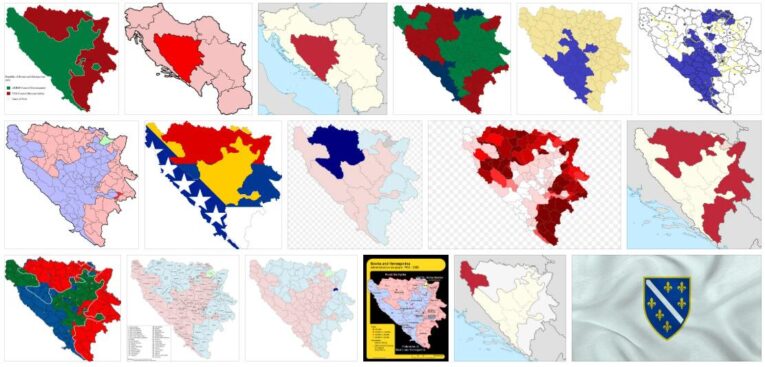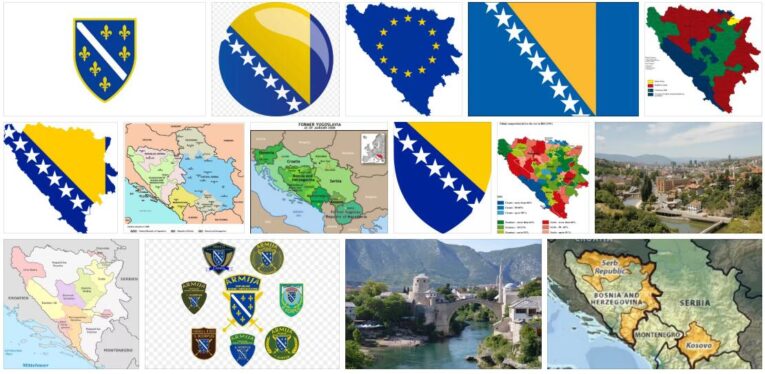Bosnia-Herzegovina is one of the successor states of the Socialist Federal Republic of Yugoslavia. It is a democratic federal republic with the independent territorial units Bosnia (Sarajevo) and Herzegovina (Mostar).
Most of the country is occupied by the forested Dinaric Mountains. Bosnia-Herzegovina has access to the Adriatic Sea only with a narrow coastal strip. The climate is predominantly continental. In the south and on the Adriatic coast, Mediterranean influences are increasing. The civil war that followed the breakup of Yugoslavia severely weakened the country and its economy. With the help of international funding, economic reconstruction has begun.
Abbreviated as BA by ABBREVIATIONFINDER, Bosnia and Herzegovina lies between Croatia and Serbia and Montenegro and has only a few kilometers wide access to the Adriatic Sea.
Surface shape
With the exception of the Sava lowlands in the north, the fertile arable and fruit-growing land of Posavina, the land is mainly occupied by the Dinaric Mountains. The highest peak is the Maglic (2386 m) on the border with Serbia.
The Dinaric Mountains are mostly covered by dense deciduous, mixed and coniferous forests. In the southern part of the country, however, the mountains have the character of a poorly forested, karstified limestone plateau with weathered calcareous soils in which larger basins, so-called poljes, are sunk. The Poljen were created by the leaching of the limestone underground by precipitation.
The central part of the country runs from NW to SE through the Bosnian Ore Mountains, an ore-rich slate and sandstone mountains.
A narrow coastal strip 20 km wide in the south of the country provides access to the Adriatic Sea.
Climate
Most of the country has a continental climate with cold winters and warm summers. The annual rainfall is about 1000 mm.
In the south of the country and on the Adriatic coast, the climate is Mediterranean with mild, rainy winters and hot summers.
Important data about the country
| Surface: | 51 129 km² |
| Residents: | 4.2 million |
| Population density: | 82 residents / km² |
| Growth of population: | 1.1% / year |
| Life expectancy: | 74 years |
| State capital: | Sarajevo |
| Form of government: | democratic federal republic with the two territorial units Bosniak-Croatian Federation of Bosnia and Herzegovina and the Serbian Republic |
| Population groups: | Bosniaks 49%, Serbs 31%, Croats 17% |
| Languages: | Serbo-Croatian as the official language |
| Religions: | Muslims (Bosniaks) 40%, Serbian Orthodox (Serbs) 31%, Catholics (Croatians) 17% |
| Climate: | temperate continental climate, Mediterranean climate in the south and on the Adriatic coast |
| Land use: | not specified |
| Economic sectors: (share of GDP) |
Agriculture 15%, industry 32%, services 53% |
| Export goods: | Wood and paper products, iron and steel products |
| Gross domestic product: | $ 6,973 million (2003) |
| Gross National Product: | US $ 1,530 / residents (2003) |
Economy
After the collapse of the SFR Yugoslavia in 1991/92, a civil war broke out in the country between Croats, Bosniaks and Serbs, in which the neighboring states of Croatia and the Federal Republic of Yugoslavia, consisting of Serbia and Montenegro, were also involved.
With the intervention of NATO forces, the extraordinarily bloody war, which claimed more than 300,000 victims, was
ended. Since the Dayton Peace Agreement in 1995, an international peacekeeping force with a UN mandate has ensured peace in the country.
The country was badly devastated by the civil war and the economy almost completely paralyzed.
Before the war, Bosnia and Herzegovina were industrially developed areas with strong iron, steel and metal processing industries.
The agricultural sector was also important. The country is also rich in mineral resources, including large iron ore and lignite deposits as well as bauxite, silver, manganese and chromium deposits in the Bosnian Ore Mountains.

